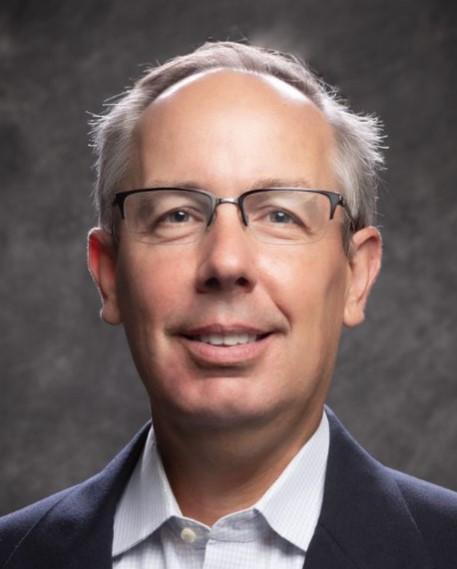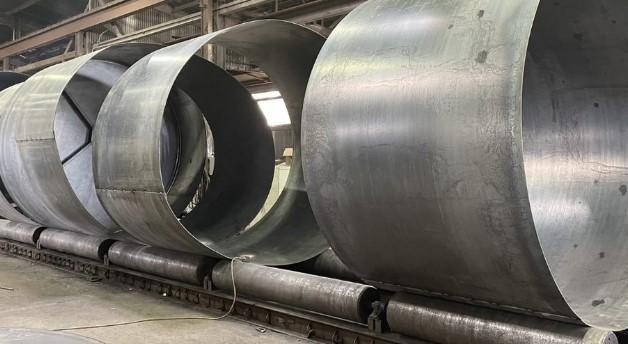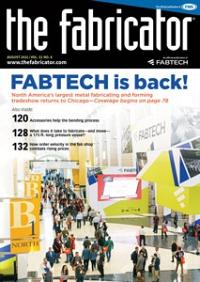Senior Editor
- FMA
- The Fabricator
- FABTECH
- Canadian Metalworking
Categories
- Additive Manufacturing
- Aluminum Welding
- Arc Welding
- Assembly and Joining
- Automation and Robotics
- Bending and Forming
- Consumables
- Cutting and Weld Prep
- Electric Vehicles
- En Español
- Finishing
- Hydroforming
- Laser Cutting
- Laser Welding
- Machining
- Manufacturing Software
- Materials Handling
- Metals/Materials
- Oxyfuel Cutting
- Plasma Cutting
- Power Tools
- Punching and Other Holemaking
- Roll Forming
- Safety
- Sawing
- Shearing
- Shop Management
- Testing and Measuring
- Tube and Pipe Fabrication
- Tube and Pipe Production
- Waterjet Cutting
Industry Directory
Webcasts
Podcasts
FAB 40
Advertise
Subscribe
Account Login
Search
Fostering a culture of ownership on the manufacturing shop floor
How a Memphis-area tank fabricator gives employees skin in the game
- By Tim Heston
- August 4, 2021
- Article
- Shop Management

A production welder brings a tank through the entire fabrication process, including rolling and welding. Newberry Tanks & Equipment
When entrepreneurs launch a fab shop, they buy some used equipment, reach out to prospects, and start hustling. They load material, run the machines, and ship parts. They own the business and its processes, from the initial order to the final shipment.
Once the company grows, owners might not run machines anymore, but with every new hire, they at least try to instill a sense of process ownership. Unfortunately, this becomes increasingly difficult as the company turns into a collection of divisions and departments. If press brake operators hear about a problem welders are having, well, that’s their problem. Of course, sloppy bending can cause welding problems, but that might not occur to brake operators in a departmentalized operation, at least not immediately. Brake operators might feel they “own” the bending process, but they—along with all front-line employees—don’t own the entire fabrication process. From this arises a fab shop’s growing pains, labor challenges, and conversations about improving shop culture.
Since the late 1980s Newberry Tanks & Equipment in West Memphis, Ark., has taken a different approach. A core group of cross-trained employees have skin in the game. The more quality tanks they fabricate in less time, the more money they make beyond their base salary. They’re not “throwing jobs over the wall” to another siloed department. Each workcell at the 53-employee operation has all the tools employees need—rolls, positioners, welding equipment—to fabricate a tank.
That model has carried Newberry through multiple downturns, including one caused by a pandemic, which the company endured without laying off, furloughing, or cutting pay or hours for a single employee.
Capacity to Grow
In 2020 business at Newberry shifted over the first six months, with some sectors shrinking significantly and others growing. “We started to see signs in July and August [of 2020] of business coming back,” said Matt Kohnke, president/COO. “With that investment in people, we could capture new business opportunities quickly ... The last quarter of 2020 was a record quarter for us.”
Kohnke clarified that Newberry isn’t immune to labor challenges. The operation could have used a few more material handlers and welders. “Still, we were able to find some really good employees through networking and recruiting through our local trade schools. We brought on some talented individuals who helped us increase our production in 2020, and they’ll help us grow through 2021.
“When you have a growing company, people want to work there,” Kohnke continued. “They know they have opportunity to grow and, ultimately, put more money into their pockets.”
A Welder at Newberry
The company’s core team of welders know how to weld, but they do more than that. “We call them ‘welders,’” said James Fischer, vice president of sales, “and they are welders in the sense that, yes, they’re welding. But they’re also fabricators and fitters. It’s a rarity that you have all those skills in one person.”
Newberry welders aren’t striking arcs all day long. When production welders arrive at work, their production supervisor gives them a job ticket, which can be for one or several tanks, depending on their size. The shop’s workcells are laid out to process two broad product families: large tanks that hold more than 4,000 lbs. and small tanks, which the shop defines as anything that holds 4,000 lbs. and less.
With the ticket in hand, welders retrieve the materials they need, perform the initial rolling, then position the rolled workpieces for tacking and welding. They add saddles, skids, and other tank components; perform postweld grinding; and prepare the tank for blasting and painting.
The company has a similar workcell dedicated to rectangular tanks, designed to hold oil for drive-up car oil change operations. In that cell, a CNC press brake (instead of a roll) forms the shell for these four-sided tanks.
Throughout the day the welders (and everyone else) perform periodic visual inspections before the tank reaches quality control. The last thing a welder wants is for QC to catch an error or subpar forming or welding. The welder is the “owner” of that tank, which means he also owns the rework.
Supporting the Newberry Welder
Of course, the welders wouldn’t be successful without other personnel dedicated to certain processes. For instance, the company does have a blasting and painting department. Having workcell-dedicated blast and paint booths—especially for some of the company’s largest tanks—just isn’t practical.
The company also has a dedicated area for producing ancillary components and tank heads. At this writing, in fact, the company is transitioning toward a Kanban system involving buffer stocks of certain items. As production welders retrieve saddles, heads, and other components, they deplete the work-in-process buffer. When the WIP buffer reaches a certain level, people in the component workcell know they need to replenish the stock.
“This way we don’t need to have someone telling them what to make,” Kohnke said, adding that it will “allow us to have more of a self-directed workforce.”
The component production area has a circle shear to make circles in sheet stock, along with welding systems and other fabrication equipment. But as of this writing, the company does not have its own sheet metal or plate cutting capability. As Kohnke explained, the complications and costs behind adding a burn table (or other cutting technology) outweigh its benefit. “We’d need the skill set to manage it, create a preventive maintenance program, add a programming function that works to maximize plate utilization. And steel is more precious than gold these days.”
The cost-benefit analysis might change down the road, of course, depending on the company’s supply situation and growth. But for now, Newberry has a solid supply base for cutting. With nearby Memphis being a logistics hub, material, while more expensive this year, at least hasn’t been scarce.
Fullbacks
Production welders need support in another way that became especially apparent in 2020: What if a production welder—a person who “owns” the tank fabrication process—were to fall ill? Before 2020, if a production welder called in sick, the company made do and pushed products through, but it was no one’s job to serve as a backup, to ensure projects kept moving forward. Kohnke formalized that backup job position soon after he joined the company in July 2020.
“I liken it to giving the ball to your fullback,” he said. “He’ll carry it 2 yards down the field, until your running back gets back into the game. And during the pandemic especially, we needed that redundancy. If employees were to be exposed to the virus and they were going to be out several weeks, we couldn’t just stop production for that long.”
Today those starting in these backup positions can work their way up to a fully cross-trained production welder position with an accompanying workcell, and to fuel future growth, the number of those positions and workcells is increasing. Two added this year increased Newberry’s production capacity by 30%.
Planning and Level-loading
After arriving last year, Kohnke implemented several changes that build upon Newberry’s strategy of welder ownership. First, to work as effectively as possible, welders (and everyone else on the floor) need to know what’s coming.
“Now we have a sales and operations planning meeting that happens on a weekly basis,” Fischer said, “which gives the plant manager insights into what the sales backlog looks like.” The plant manager in turn passes this information on to welders and others on the front line, who now know what will be arriving on the shop floor in the weeks ahead and can plan accordingly.
Second, Newberry implemented its Preferred Customer Program, in which customers sign on to receive a certain volume of tanks over a certain time period. The customer locks in competitive pricing, including material and labor pricing at the time of fabrication. Newberry keeps tanks in inventory, which preferred customers can pull from as needed. The customer gets a tank delivered within days (instead of weeks), and Newberry benefits by being able to level-load the shop.
“The worst thing we can do is leave a workcell vacant for a period of time,” Fischer said, adding that such vacancies become real possibilities with highly variable demand. With the oil and petroleum market as the fabricator’s primary sector, customer demand at Newberry is unavoidably variable. To maintain customer satisfaction, the shop needs to build in enough capacity to handle periods of peak demand. Question is, what does the shop do with that capacity when demand falls?
The Preferred Customer Program helps manage that variability. Inventoried tanks are kept between a minimum and maximum level. During slower times the shop produces Preferred Customer tanks up to that maximum inventory level, taking advantage of capacity that would otherwise be left unutilized.
Training and Retention
Having a “process owner” carrying a product through rolling, fitting, and fabrication sounds ideal. But people with such a diverse skill set are a rare find. What if a production welder leaves?
As Kohnke explained, the backup teams can help in the short term, and the company maintains a training pipeline for those who aspire to be production welders. Most of the company’s production welders have more than 10 years on the job, and they won’t be working forever. That said, turnover remains low thanks in large part to the company’s process-ownership strategy.
The strategy also supports a culture of sharing knowledge. After all, the more successful the company is, the more its workers make, and that can’t happen if people keep what they know to themselves. Welders are paid by not how much weld bead they lay down in an hour, but the value of tanks that ship out the door during a certain period. In this situation, why would they keep what they know to themselves?
“Our production welders are very experienced, and they always welcome the chance to pass on knowledge to the next generation,” Kohnke said. “They have a unique skill set that, in our view, makes us different from many others.”
The entrepreneurial Operating System and the Pandemic
Matt Kohnke joined West Memphis, Ark.-based Newberry Tanks & Equipment in July 2020 as president and COO—chief operating officer, not chief executive officer. The latter title is held by Newberry’s owner, Chris Long. The company doesn’t have a president and CEO in large part because of the Entrepreneurial Operating System (EOS) it has implemented.
“In an EOS model, you have a visionary, which is typically the CEO, and then you have an integrator, which is usually the president,” Kohnke said. “Chris was looking to get out of the day-to-day running of the business to focus more on vision and strategy.”
July 2020 might seem like a tumultuous time to change company leadership. Business had shifted during the first six months of the year, and Newberry was gearing up for what everyone hoped to be a sustainable recovery.
But as Kohnke explained, the timing actually benefited the company. As the new president and COO, Kohnke helped ramp up new customer programs, refined operations, and continued managing Newberry’s COVID response.
The company had shifted to a 4-day, 10-hour workweek. “One less day of production further limited our exposure,” Kohnke said, adding that the company arranged to have lunch delivered in-house, at the company’s cost, and established a rotating lunch schedule.
Kohnke’s work in the business helped Long focus on the business—a good thing to do given all the uncertainty. “Things were changing rapidly during the pandemic,” Kohnke said, “so it was good to free up Chris so he could keep focusing on those strategic opportunities so critical for the long-term health of the business.”
About the Author

Tim Heston
2135 Point Blvd
Elgin, IL 60123
815-381-1314
Tim Heston, The Fabricator's senior editor, has covered the metal fabrication industry since 1998, starting his career at the American Welding Society's Welding Journal. Since then he has covered the full range of metal fabrication processes, from stamping, bending, and cutting to grinding and polishing. He joined The Fabricator's staff in October 2007.
subscribe now

The Fabricator is North America's leading magazine for the metal forming and fabricating industry. The magazine delivers the news, technical articles, and case histories that enable fabricators to do their jobs more efficiently. The Fabricator has served the industry since 1970.
start your free subscription- Stay connected from anywhere

Easily access valuable industry resources now with full access to the digital edition of The Fabricator.

Easily access valuable industry resources now with full access to the digital edition of The Welder.

Easily access valuable industry resources now with full access to the digital edition of The Tube and Pipe Journal.
- Podcasting
- Podcast:
- The Fabricator Podcast
- Published:
- 04/16/2024
- Running Time:
- 63:29
In this episode of The Fabricator Podcast, Caleb Chamberlain, co-founder and CEO of OSH Cut, discusses his company’s...
- Trending Articles
How to set a press brake backgauge manually

Capturing, recording equipment inspection data for FMEA

Tips for creating sheet metal tubes with perforations

Are two heads better than one in fiber laser cutting?

Hypertherm Associates implements Rapyuta Robotics AMRs in warehouse

- Industry Events
16th Annual Safety Conference
- April 30 - May 1, 2024
- Elgin,
Pipe and Tube Conference
- May 21 - 22, 2024
- Omaha, NE
World-Class Roll Forming Workshop
- June 5 - 6, 2024
- Louisville, KY
Advanced Laser Application Workshop
- June 25 - 27, 2024
- Novi, MI





























